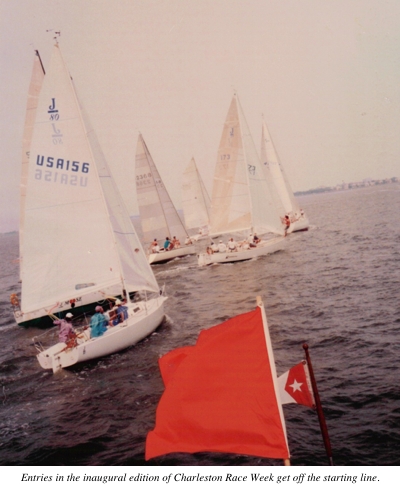Something that I have been involved with this year is helping to prepare from Charleston Race Week with Clean Regattas. Clean Regattas is an organization that encourages regattas to practice sustainability to protect our oceans. You can register a regatta and form a green team on the Clean Regattas website. I sail for the college, and am a Sustainable Urbanism major with a Sustainability minor, so this event was interesting to me in many ways.
Charleston Race Week is the biggest keelboat regatta in America, hosted here in Charleston, and is sponsored by Sperry. Charleston Race Week is now in its 21st year (the regatta was established in 1996). In 2006, Charleston Race Week drew entries from as far away as England, Canada, Michigan, and California, with more than 70 percent of the competitors arriving from out of town. The story was much the same in 2007 and 2008, with increased numbers of participants each year. The event has grown by an average of 15 percent in recent years and evolved to become the largest keelboat regatta in the Western Hemisphere.

Clean regattas is the world’s only sustainability certification for water-based events.
Over 1,000 regattas, gams, rallies and cruises have registered as Clean Regattas. One part education, two parts activation, the program unites and mobilizes sailors by offering support and resources to help conserve and protect the ocean.
Working with Clean Regattas, you are part of a green team that is dedicated to sustainability. You assess, begin, and follow through on clean regatta initiatives. You then document these initiatives. Some initiatives include:
- Paperless regattas- going paperless for your regatta registrations and Notice of Race, and prioritizing paper communications.
- Reduce plastic water bottles- provide or encourage the use of reusable water bottles (On average, Americans throw away 2.5 million plastic bottles every hour and many of them end up in the landfill, or worse, your local waterway.)
- Responsible dinnerware- most regattas will provide a mean for their participants, and clean regattas encourages regattas to utilize responsible dinnerware that can be composted or recycled.
- More responsible awards- Regatta trophies can be very energy-intensive to create and often end up sitting on a dusty shelf somewhere, so regattas are encouraged to find alternative trophy options.
- Good Waste Management- Well-labeled bins and volunteers to help point people in the right direction are paramount to an event having good waste management.
- Toxic-free Cleaning- You can request all participants limit their impact on local water quality by using “water only washdowns” (“WOW!”) at the end of racing. After most sailboat racing, competitors will wash salty water or other substances off of their boats (its bad for the boat if you leave it on there) and use harsh chemicals that usually run into the water. Hull scrubbing can lead to the build up of toxic chemicals in your local waters as well as the potential introduction of invasive species.
- Efficient Power Boats- You can request that regattas utilize lightweight, fuel-efficient rigid inflatable boats (RIBs). These boats use carbon fiber and weigh a third of the weight of a normal RIB, while using only 20 percent of the fuel.
- Trash cleanup- you also can go through the regatta site and clean up trash after the event.
Sailors for the Sea is the world’s leading conservation organization that engages, educates, inspires and activates the sailing and boating community toward healing the ocean. Their global affiliates help expand this mission across the globe. They work in places from Japan, to Portugal, to the US.
